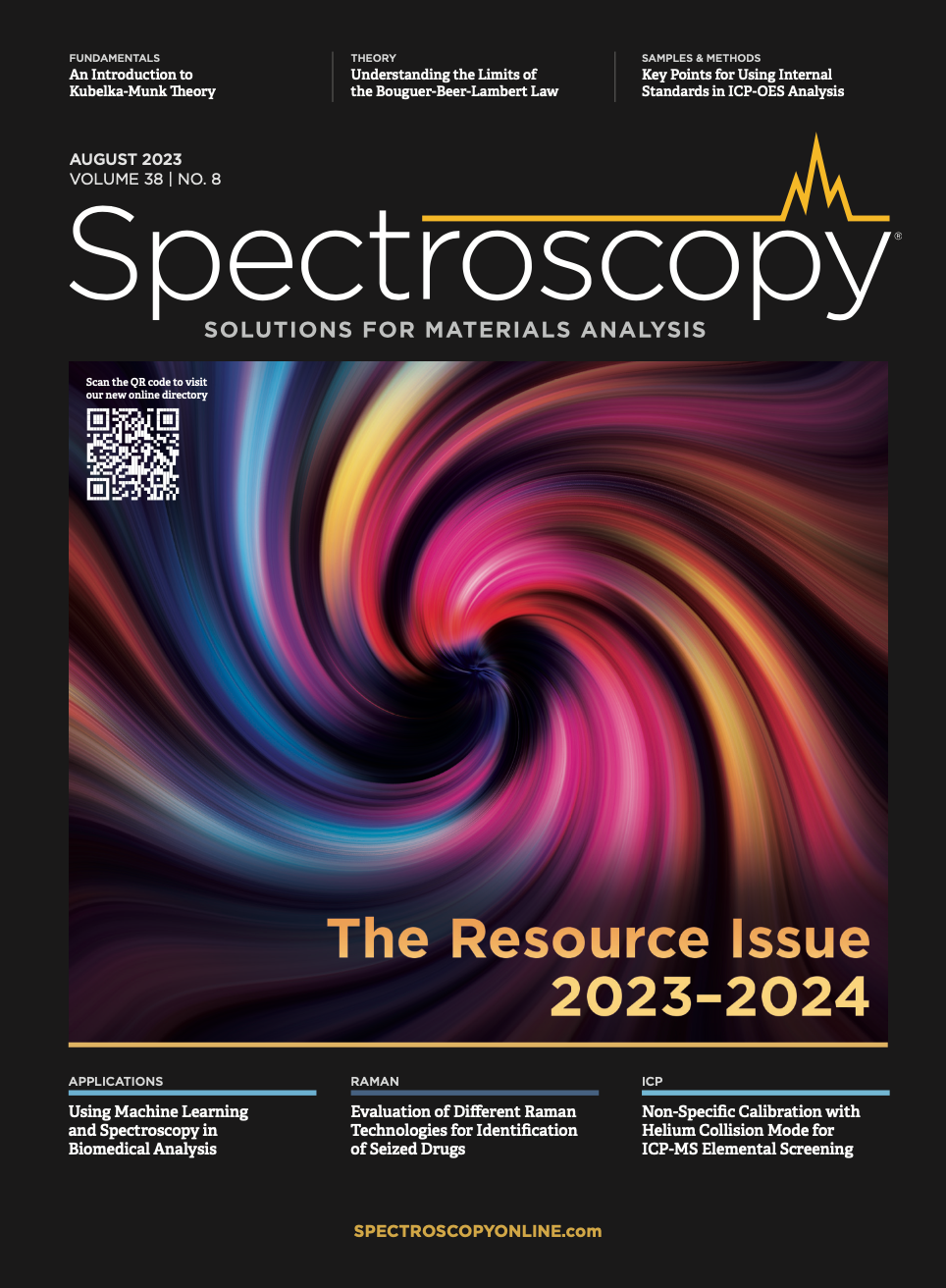New Analytical Tools for Biomedical Applications Using Machine Learning and Spectroscopy
The assessment and monitoring of the growth and response of bacteria to antibiotics is of crucial importance in research laboratories, as well as in food, the environment, medical, and pharmaceutical applications. James Chapman of RMIT University in Melbourne, Australia and his colleagues have been actively exploring the ability of near-infrared (NIR) and UV‐visible (UV-Vis) spectrophotometry, combined with machine learning tools (such as partial least squares discriminant analysis) to examine, measure, and monitor bacterial growth phases when treated with antibiotics. Chapman spoke to Spectroscopy about his efforts.
In a recent published paper utilizing near-infrared spectroscopy (1), you state that the measurement of the growth phases in bacteria using optical density at 600 nm (OD600) has been the “gold standard” for the industry and research laboratories. Why do you believe that this has been the case and what have you discovered that might challenge this convention?
The use of OD600 represents the single quickest measurement of many pathology, microbiology, and biochemistry laboratories, routinely used to determine the number of cells in a solution. This measurement is based on well-established science using turbidity and the Beer-Lambert law as a measure for cells grown in the solution obtaining a concentration estimate of cells per unit volume. This OD600 measurement can be achieved on a multiwavelength or single wavelength spectrophotometer, which as you all will know, these instruments are abundant in most laboratories.
Our discovery came about when we were using the multiwavelength spectrophotometer, where we hypothesized that common biochemical information is being lost or not even looked at in the whole spectrum. We thought that key pieces of information can be obtained from the spectra were taking, for example DNA absorbs at 260 nm and RNA absorbs in the 280 nm of the UV-Visible region, RNA, among other important biochemicals. We see these pieces of the puzzle as extra information while also obtaining cell numbers, this multicomponent information increases the ability to assign a fingerprint of what is going on in our system. The result of which is, we can understand microbial interactions with the antimicrobial agent and all within the complex matrix using the spectrophotometer.
In a second published paper (2), you investigate the potential of UV‐vis spectrophotometry to examine bacterial growth phases when treated with antibiotics, showcasing the ability to understand the point of resistance when an antibiotic is introduced into the media and therefore yielding improved understanding of the biochemical changes of the infectious pathogens. How would you compare NIR and UV-vis as optimum methods for assessing bacterial counts? How do these two methods compare with other available analytical techniques in terms of speed and accuracy?
We use these two methods for two reasons, the first being that NIR can measure the sample with a greater degree of energy penetration, and UV-vis spectrophotometry provides us with a multi-parameter method to ascertain more than just the standard optical density method. Both are very different methods, but when combined, provide very powerful information for antimicrobial resistance applications. For example, we can scan samples through the sample vials with NIR, and don’t need as much sample preparation; all key methods when time is of the essence.
The spectroscopic methods we use are rapid, non-destructive, green techniques if you will. This provides us with the bonus of less sample preparation, less sample destruction, and near-instantaneous measurement of the samples. We can also perform high-throughput sampling using the methods we have developed. Comparing these to established, yet highly qualitative and quantitative methods like GC–MS, NMR, or LC–MS, its horses for courses; with some techniques you require the lower limits of detection, but if it is the information you require in a rapid way, then spectrophotometry is the way to do it. For example, it currently takes up to one week to get a diagnosis for antimicrobial contamination and treatment. Pushing the time boundaries using our developed methods means that we can explore reducing the timeframes for antimicrobial diagnostics.
How would you distinguish the use of the terms artificial intelligence and machine learning? Do you think artificial intelligence could be of value for this application?
Artificial Intelligence is the overall term which encompasses machine learning. Therefore, any use of machine learning is a form of AI. AI is imperative to all applications of these type. It will be able to revolutionize the methods and generate faster responses to diagnostics—we feel that these are imperative to the design of new analytical systems coming into the future. Additionally, once we automate the process of analyzing data, this will lead to better AI models and the ability to understand and characterize an unknown system in far quicker times.
How does this work differ from what has been previously done by yourself or others?
Our group’s work is cutting edge and is some of the first to be reported in this area. Examining multiparameter systems in complex matrices is unheard of, given that the analytical method typically aims to extract the analyte of interest first, this can be readily achieved through solid phase extraction, sample clean-up, chromatography for example. However, our method extracts this information in a single step even when measuring in a complex matrix of antibiotics, microorganisms, and the nutrient broth that the microbes are measured in.
Please summarize your findings.
We demonstrate the use of rapid spectrophotometric and high-throughput methods which when combined with chemometrics and machine learning algorithms can be used to obtaining really fundamental information on the type, level of resistance, and the dose of antibiotic necessary to establish optimum diagnosis, treatment, and decontamination strategies. Our early methods can show that adding different concentrations of broad‐spectrum antibiotics to growth medium creates unique changes in the UV‐Vis and NIR spectra. Once we apply our preprocessing techniques to the data, we can obtain more information which allows us to monitor and differentiate treatments.
Were there any limitations or challenges you encountered in your work?
As with all experimental and scientific work, challenges always exist. We are working on obtaining better limits of detection and trying to train our AI systems to have improved quantitation for the models we make. The ability to sort, process, and analyze data is still very much manual; but our group and PhD students are working hard to develop automation. The types of projects we have a re largely multidisciplinary and require several discipline teams to solve these issues, therefore we have mathematicians, chemometricians, materials scientists, computer scientists, biologists, and chemists in the Chapman group all working hard to solve these challenges.
Can you please summarize the feedback that you have received from others regarding this work?
We have received so much interest in this work so far. Industry is keen to partner with us and we have many collaborators now internationally who are looking to broaden the application base, for example, cancer detection in tissue biopsy (looking for those key biochemical markers). We are always looking for new collaborations and challenges to work on, so this network base is rather dynamic, and we welcome anyone to join with us.
What are the next steps in this research?
We are already working on several steps in this work and will be publishing that imminently where we are focused on improving limits of detection, working with multi-polymicrobial samples (reflecting real-world issues better), and different antimicrobial agents including newly developed antimicrobial agents. We are a young and dynamic team, developing new antimicrobial solutions is also another wing within our group, hence characterizing such systems and interactions is at the forefront of what we do. We have automated many of the steps and are now generating deep learning methods. The next stage will be to utilize hyperspectral systems to perform these measurements; all using the spectra, analyzed using chemometrics, and all automated using AI. It’s really, really exciting.
References
(1) Truong, V. K.; Chapman, J.; Cozzolino, D. Monitoring the Bacterial Response to Antibiotic and Time Growth Using Near-Infrared Spectroscopy Combined with Machine Learning. Food Analytical Methods 2021, 14, 1394–1401. DOI: https://doi.org/10.1007/s12161-021-01994-6
(2) Chapman. J.; Orrell‐Trigg, R.; Kwoon, K. Y.; Truong, V. K.; Cozzolino, D. A High‐Throughput and Machine Learning Resistance Monitoring System to Determine the Point of Resistance for Escherichia coli with Tetracycline: Combining UV‐Visible Spectrophotometry with Principal Component Analysis. Biotechnol. Bioeng. 2021, 118 (4), 1511-1519. DOI: https://doi.org/10.1002/bit.27664
About the Interviewee
James Chapman is an Associate Professor at RMIT University (Australia), and a Program Manager for the Applied Chemistry and Environmental Sciences which includes several degree programs, previously holding roles of Head of Science at Central Queensland University (Australia). He has a BSc (Hons) in Analytical Chemistry from the University of Plymouth (UK) and a PhD in Biofilms and Contamination of Surfaces Characterised Using Analytical Chemistry from Dublin City University (Ireland). His research is motivated by the development of rapid analytical tools to generate new sensors for applications in health, food, and the environment. James has authored >100 articles (i10-index 75, h-index 32, 3657 cites: Google Scholar). He is the Division Chair for The Royal Australian Chemical Institute for Analytical and Environmental Chemistry, a Fellow of the Royal Society of Chemistry and Royal Australian Chemical Institute, and a Chartered Chemist. He is an active member of the spectroscopy community and is a Program Advisory Committee for the Australian Nuclear Science and Technology Organisation (ANSTO).
James is a Principal Investigator and has a research group consisting of 10 PhD, 2 MSc, and 2 honours students as Principal and Associate Supervisor. He has completed 7 PhD students to completion since 2016. His group work on a range of environmental, health, and food based analytical chemistry-based projects underpinned by spectroscopy, chemometrics, and Artificial Intelligence.


New Spectroscopic Study Examines Hazelnut Authentication Methods
March 31st 2025A new study published in Spectrochimica Acta Part A: Molecular and Biomolecular Spectroscopy demonstrates that near infrared (NIR) spectroscopy is a highly accurate and reliable method for authenticating hazelnut cultivars and geographical origins.
Exoplanet Discovery Using Spectroscopy
March 26th 2025Recent advancements in exoplanet detection, including high-resolution spectroscopy, adaptive optics, and artificial intelligence (AI)-driven data analysis, are significantly improving our ability to identify and study distant planets. These developments mark a turning point in the search for habitable worlds beyond our solar system.